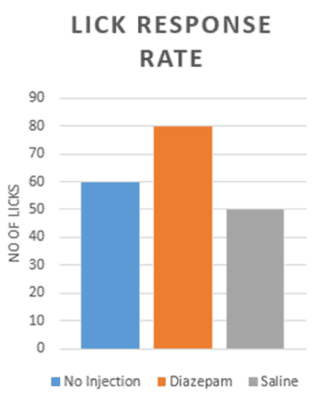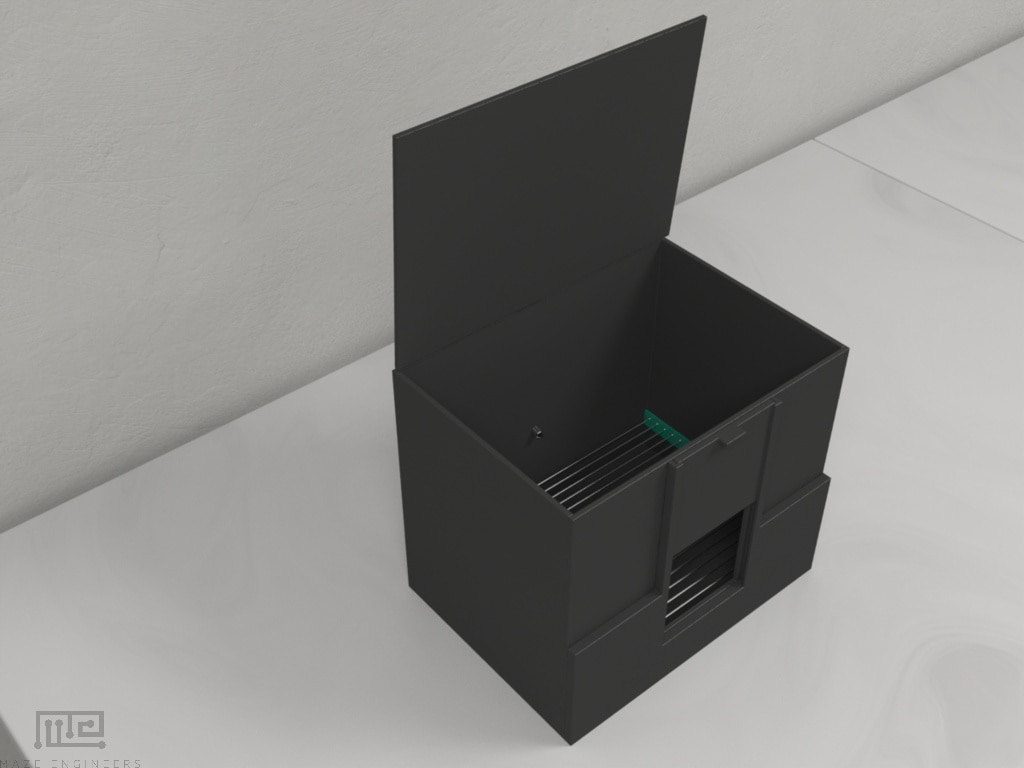Description
The Vogel test is a classic protocol where rodent subjects are water deprived and then placed in the an apparatus while simultaneously exposed to punishment in the shape of a mild shock whenever fluid is retrieved. It is used for measurement of the ability of drugs to alter the drinking behavior in these water deprived rodents. The MazeEngineers Vogel’s test apparatus includes the following key features to help your experiments succeed:
- Lickometer with ability to sense licks and log in Conductor.
- Configurable Shock plate
- Easy to clean and remove fecal & urine chamber.
- The Conductor Software records experiments up to 10 hours long. During this time many parameters can be controlled as discussed in the Features section.
- Interchangable colors and plates for video grading
Features
Sturdy Chamber
- Acrylic chamber with insertable shock
- Easy to remove feces/waste collector for easy clean
Lick
- Optical detection of lick
- Adjustable liquid volume
- Adjustable lick sensitivity
- Automated Data collection
- Automated liquid pattern dispense
Shock
- Smooth DC Shock Delivery
- Output Current: 0 – 4mA
- Adjustable in 0.1mA increments
- Voltage: 163V (direct current)
Easy Automation
- Recording interval (1-10 hours)
- Number of licks per shock
- Shock Length: 0-10s
- Lick to Shock Ratio
- Number of licks and pattern
- Number of shocks and pattern
- All data exportable to Excel
Take advantage of Neuralynx, Ethovision Integration, SMS and Email integration with the Conductor Science Software. No I/O Boxes Required
Price & Dimensions
Mouse Chamber
$ 3900
Per Month- Length: 25cm
- Width: 25cm
- Height: 20cm
Rat Chamber
$ 4900
Per Month- Length: 35cm
- Width: 35cm
- Height: 30cm
Documentation
Introduction
Vogel Conflict Test (VCT) is a widely used technique that is employed as the screening method for drugs having apparent anxiolytic properties.
Vogel Conflict Test introduced in 1971 by Vogel is the prevailing paradigm (Vogel et al., 1971). Numerous paradigms were introduced to create a conflict situation in subjects as it is critical to evaluate the working of anxiolytic agents.
Geller and Seifter introduced the pioneer paradigm in 1960. In their model, mice or rat had to press the lever for a food reward. Vogel’s model is the modification of the Geller-Seifter paradigm.
In this classical model, subjects were water deprived for 2 days and then placed in the VCT apparatus for 3 minutes testing period. It measures the ability of the drugs to alter the drinking behavior of water deprived rats exposed to punishment in the shape of a mild shock.
Benzodiazepine (diazepam) and barbiturate (pentobarbital) produced significant anticonflict effects, which means that these drugs increased the number of electric shocks subjects received during the test session. On the contrary, amphetamine does not produce anticonflict effects (Stephens & Andrews, 1991).
A specific drug-induced increase in the number of shocks taken (equivalent to water drunk) is considered to reflect anxiolytic properties.
Apparatus & Equipment
The test apparatus consists of a plexiglass chamber (usually approx. 38x 38 cm). The base of the chamber is provided with a grid made up of stainless rods. The wall of the chamber is provided with a bottle spout for drinking purpose (Vogel et al.).
The number of licks of the spout is counted. The current is switched on 2 seconds after the subject begins to drink, and every 20th lick is punished by an electric shock with the intensity of approx. 0.5mA through the grid, which constituted the base of the chamber. The test is continued for 3 minutes, and the drug under consideration is injected half an hour before testing.
Training Protocol
Housing Protocols
Vogel’s version lacked information regarding the housing of the subjects. The study did not specify if animals were housed in groups or were housed individually. Modern studies utilize both types of housing which can have diverse results (Millan et al).
A later study housed mice in Plexiglass cages (10 mice/cage) that consisted of wooden flake bedding and stainless steel wire mesh tops (Umezu T et al.)
Before testing, animals were deprived of water for 2 days to induce thirst. The animals were housed in an artificially illuminated room on a 12-hour light dark schedule. The temperature was maintained at 25 ±1.0.
Pre-training for VCT
Habituation: On the first day of the drug effect experiment, individual animals that have been deprived of water for 48 hours were put into separate chambers and were accustomed to the test chambers for 40 minutes.
One week later, the same animals, which had again been deprived of water for 48 hours before the test, were introduced in the chamber 30 minutes after administration of the drugs or their vehicle (Umezu, 1999).
The subjects promptly find the bottle spout during the test if they are water restrained. Additionally, providing subjects limited access to water daily over the training period permits it to be protracted for a longer duration, thereby increasing stability and reproducibility of performance.
Modifications
There are two documented modifications of the Vogel conflict test.
One modification was established at the Russian Academy of Medical Sciences. It was acclaimed as the reference for the study of the anxiolytic activity of pharmacological agents (Ed. R. U. Khabriev et al., 2005).
The experiments were conducted on outbred white male rats with the body weight ranging from 200 to 250 g and were housed in groups of 5 per cage. On the first day of the experiment, the subjects were completely dispossessed of water. After 24 hour dispossession, the rats learned how to get water from the bottle spout located in the experimental chamber (27.5×27.5×45 cm).( G. M. Molodavkin, T. A. Voronina, 1995)
On the third day, again after 2 days water dispossession, the rats were placed again in the experimental chamber. After 10 seconds of the first water intake, constant current (0.2mA) was delivered on the spout of a drinking bottle and the electrode base of the chamber. Each water intake was punished, and the testing duration was 10 minutes. However, the tested drug was administered 30 minutes before the test.
Porsolt and partners Pharmacology (France) developed and validated another modification of the Vogel conflict test. (V. Castagné et al., 2008)
The experiments were conducted on male Rj: Wistar (Han) rats with the body weights ranging from 160 to 227 g. Five subjects were housed per cage.
After 48-hour water deprivation, rats were introduced in a transparent plexiglass chamber (15×32×34 cm) with the floor made up of stainless rods that were 0.4 cm in diameter and each rod was 1 cm apart.
The posterior wall of the chamber was made up of opaque plexiglass chamber with the intention to hide the observer. On the opposite wall of the opaque wall, a water bottle was placed in the center 5cm above the floor.
One pole of the shock generator was connected to the bottle, and the other was attached to the metal rod floor. Every time the rat licked the bottle spout, an electric shock (1.7mA) was generated after 2 seconds. The test duration was 3 minutes, and the tested drug was injected one hour before the test.
Sample Data

Vehicle treated control group is administered with a saline solution whereas the intervention group is injected with the drug under study. An example graph depicts the lick response rate of the subjects under three states i.e. no injection state, diazepam administrated state, and the saline administrated state.
Strengths and Limitations
Strengths
The Vogel conflict test has well-documented importance regarding the characterization of diverse classes of anxiolytics. Additionally, it is believed to have considerable scope for its continuity and enhanced application in the identification of novel agents and the assessment of their mechanism of action.
VCT has the advantage of eliminating the problems that arise in the Geller-Seifter model. With VCT, the necessity for daily and long-term training of subjects is no longer a problem. Furthermore, the problem of repeated utilization of the subjects (exposure to drugs may alter the results when the same subjects are utilized again and again) is also solved.
Later versions of the Vogel conflict test intended to improve repeated utilization by pre-selection of subjects that drink water from the spout but are sensitive to shock-induced suppression (Petersen & Lasssen, 1981; Petersen & Lasssen, 1984)
Limitations
Despite the exceeding efficiency regarding classical anxiolytics, the test is susceptible to numerous variables, such as pain, learning and memory, and thirst. These variables can impede the interpretation of the results.
As anxiety is idiopathic, therefore the animal models are hard to create and are usually inconsistent. Besides the classical anxiolytics, SSRIs which will theoretically increase the number of responses, display no effect in the Vogel conflict test (Millan, Mark J, et al., 2003)
The VCT can also exhibit false positives. For instance, if the intensity of the shock is too low, then subjects might disregard the shock and continue to drink water from the spout which can make the results unreliable. Drugs that enhance the thirst can also give faulty results (Witkin, Jeffrey, 2011)
The chief drawback of the Vogel conflict test is the lack of a systemic exploration of drug effects on non-conflict behavior (Green & Hodges, 1991)
Summary and Key Points
- VCT is the widely employed test to evaluate the working of anxiolytics.
- VCT is a sophisticated five plexiglass chamber provided with metal rods that form the base of the chamber.
- Subjects must pass the various training protocols for habituation procedure to get familiar with the test apparatus
- Two documented modifications of the Vogel conflict test are available.
- VCT is of considerable use for the rapid exploration of anxiolytic and anxiogenic effects of drugs.
References
- Vogel, B. Beer, D. E. Clody, Psychopharmacologia, 21, No. 1, 1-7 (1971).
- Stephens, D.N., & Andrews, J.S. (1991). Screening for anxiolytic drugs. In P. Willner (Ed.).Behavioral models in Psychopharmacology. Cambridge University Press, Cambridge.
- Millan, Mark; Brocco, Mauricette (2003). “The Vogel conflict test: procedural aspects, g-aminobutyric acid, glutamate and monoamines”. European Journal of Pharmacology. 463: 67–96
- Umezu, T. (1999), Effects of psychoactive drugs in the Vogel conflict test in mice. Japanese Journal of Pharmacology, 80
- Guidelines for Experimental (preclinical) Investigation of New Pharmacological substances [In Russian], Ed. R. U. Khabriev, Moscow (2005).
- M. Molodavkin, T. A. Voronina, Ibid., 58, No. 2, 54-56 (1995).
- Castagné, M. Lemaire, I. Kheyfets, et al., J. Pharm. Phar macol., 60, No. 3, 309-316 (2008).
- Petersen, E.N., & Lassen, J.B. (1981). A water-lick Conflict Paradigm Using Drug Experienced Rats. Psychopharmacology, 75, 236-239.
- Petersen, E.N., & Jensen, L.H. (1984). Proconflict Effect of Benzodiazepine Receptor
- Inverse Agonists and Other Inhibitors of Gaba Function. European Journal of Pharmacology, 103, 91-97.
- Millan, Mark J (2003). “The neurobiology and control of anxious states”. Progress in Neurobiology. 70: 83–244.
- Witkin, Jeffrey (2011). “A Vogel Conflict Test Using Food Reinforcement in Mice”. Mood and Anxiety Related Phenotypes in Mice. 63: 159–169.
- Green, S., & Hodges, H. (1991). Animal models of anxiety. In: P. Willner (Ed.) Behavioral models in Psychopharmacology. Cambridge University Press, Cambridge, pp. 21- 49.




